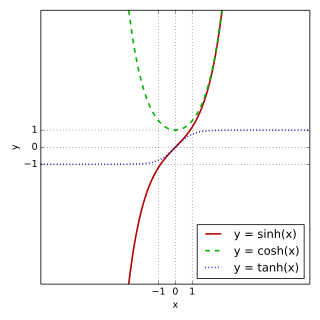Υπερβολικές συναρτήσεις
From Wikipedia, the free encyclopedia
Στα μαθηματικά, οι υπερβολικές συναρτήσεις είναι ανάλογες των συμβατικών τριγωνομετρικών ή κυκλικών συναρτήσεων. Οι βασικές υπερβολικές συναρτήσεις είναι το υπερβολικό ημίτονο (συμβολίζεται sinh) και το υπερβολικό συνημίτονο (cosh), από τις οποίες προκύπτουν η υπερβολική εφαπτομένη (tanh) και οι υπόλοιπες υπερβολικές, κατ' αναλογία των παράγωγων τριγωνομετρικών συναρτήσεων. Οι συναρτήσεις αυτές ονομάστηκαν έτσι επειδή η γεωμετρική σχέση τους με μία υπερβολή είναι σχεδόν ίδια με την σχέση των τριγωνομετρικών συναρτήσεων με την περιφέρεια.[1]


Αλγεβρικές εκφράσεις
- Υπερβολικό ημίτονο
- Υπερβολικό συνημίτονο
- Υπερβολική εφαπτομένη
- Υπερβολική συνεφαπτομένη
- Υπερβολική τέμνουσα
- υπερβολική συντέμνουσα
Όπου είναι η φανταστική μονάδα που ορίζεται ως .
Χρήσιμες σχέσεις
Οπότε:
Προκύπτει δηλαδή ότι οι cosh x και sech x είναι άρτιες συναρτήσεις, ενώ οι υπόλοιπες είναι περιττές συναρτήσεις.
Τα υπερβολικά ημίτονα και συνημίτονα ικανοποιούν τη σχέση:
η οποία είναι αντίστοιχη της συμβατικής τριγωνομετρικής σχέσης:
Η υπερβολική εφαπτομένη είναι λύση του μη γραμμικού προβλήματος οριακών τιμών.[2]:
Αντίστροφες υπερβολικές εκφρασμένες με λογάριθμους
Παράγωγοι
Συνήθη ολοκληρώματα
Στις πιο πάνω σχέσεις, C καλούμε την σταθερά ολοκλήρωσης.
Σχέσεις με σειρά Τέιλορ
Είναι δυνατόν να εκφράσουμε τις υπερβολικές συναρτήσεις με χρήση σειράς Taylor:
- (Σειρά Laurent)
- (Σειρά Laurent)
όπου
- είναι ο νιοστός αριθμός Μπερνούλι
- είναι ο νιοστός αριθμός Όιλερ
Αναφορές
Δείτε επίσης
Wikiwand - on
Seamless Wikipedia browsing. On steroids.
























































